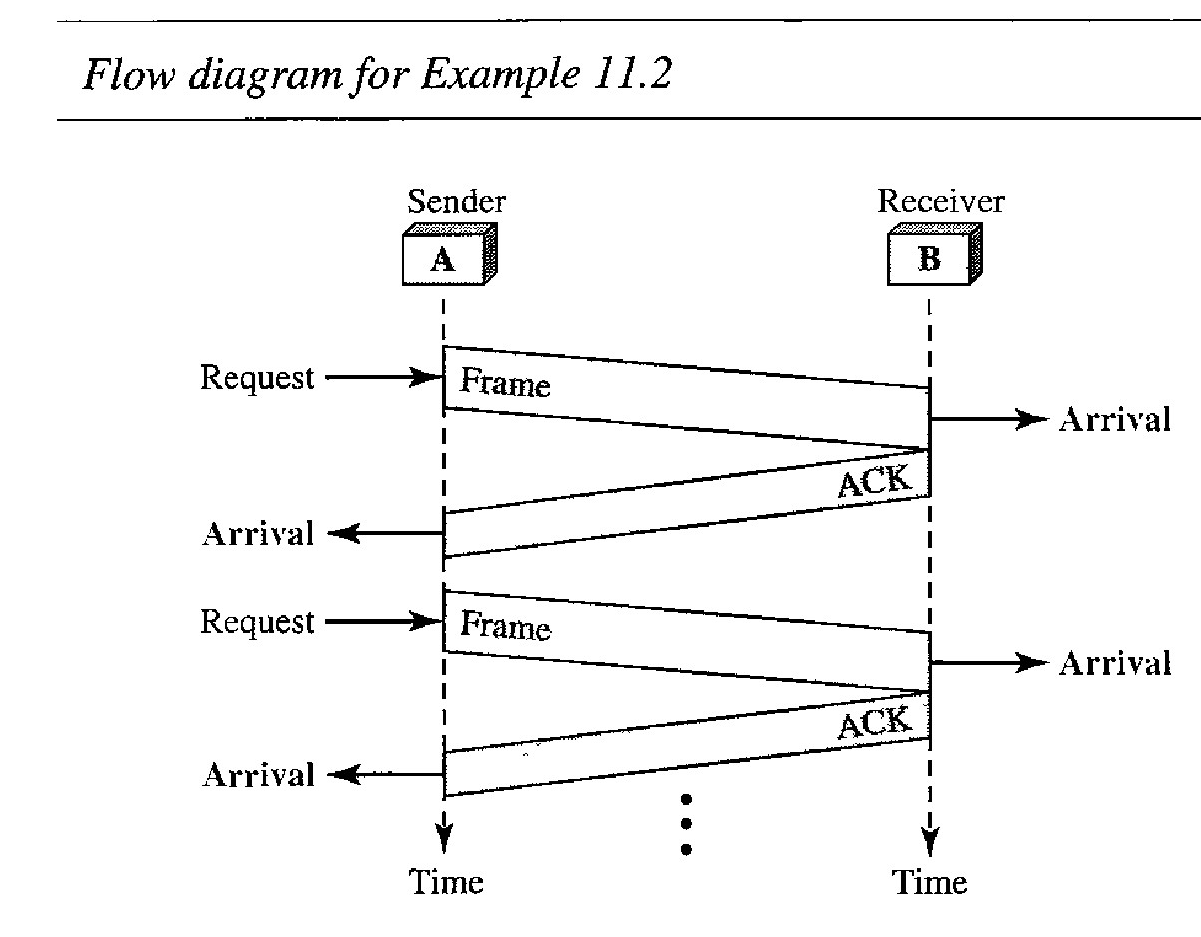Data Link Control
The two main functions of the data link layer are data link control and media access control.
The first, data link control, deals with the design and procedures for communication between two adjacent nodes: node-to-node communication.
The second function of the data link layer is media access control, or how to share the link.
Data link control functions include framing, flow and error control, and softwareimplemented protocols that provide smooth and reliable transmission of frames between nodes.
To implement data link control, we need protocols. Each protocol is a set of rules that need to be implemented in software and run by the two nodes involved in data exchange at the data link layer.
FRAMING
Data transmission in the physical layer means moving bits in the form of a signal from the source to the destination. The physical layer provides bit synchronization to ensure that the sender and receiver use the same bit durations and timing.
The data link layer, on the other hand, needs to pack bits into frames, so that each frame is distinguishable from another.
Framing in the data link layer separates a message from one source to a destination, or from other messages to other destinations, by adding a sender address and a destination address. The destination address defines where the packet is to go; the sender address helps the recipient acknowledge the receipt.
Although the whole message could be packed in one frame, that is not normally done. One reason is that a frame can be very large, making flow and error control very inefficient.
When a message is carried in one very large frame, even a single-bit error would require the retransmission of the whole message. When a message is divided into smaller frames, a single-bit error affects only that small frame.
Frames can be of fixed or variable size. In fixed-size framing, there is no need for defining the boundaries of the frames; the size itself can be used as a delimiter. An example of this type of framing is the ATM wide-area network, which uses frames of fixed size called cells.
Variable-size framing is prevalent in local area networks. In variable-size framing, we need a way to define the end of the frame and the beginning of the next.
Two approaches for Variable-Size Framing
Character-Oriented Protocols :
In a character-oriented protocol, data to be carried are 8-bit characters from a coding system such as ASCII
The header, which normally carries the source and destination addresses and other control information, and the trailer, which carries error detection or error correction redundant bits, are also multiples of 8 bits.
To separate one frame from the next, an 8-bit (l-byte) flag is added at the beginning and the end of a frame. The flag, composed of protocol-dependent special characters, signals the start or end of a frame.
Character-oriented framing was popular when only text was exchanged by the data link layers. The flag could be selected to be any character not used for text communication.
Now, however, we send other types of information such as graphs, audio, and video. Any pattern used for the flag could also be part of the information. If this hap- pens, the receiver, when it encounters this pattern in the middle of the data, thinks it has reached the end of the frame.
To fix this problem, a byte-stuffing strategy was added to character-oriented framing. In byte stuffing (or character stuffing), a special byte is added to the data section of the frame when there is a character with the same pattern as the flag.
The data section is stuffed with an extra byte. This byte is usually called the escape character (ESC), which has a predefined bit pattern. Whenever the receiver encounters the ESC character, it removes it from the data section and treats the next character as data, not a delimiting flag.
However if the text contains one or more escape characters followed by a flag then the receiver removes the escape character, but keeps the flag, which is incorrectly interpreted as the end of the frame. To solve this problem, the escape characters that are part of the text must also be marked by another escape character. In other words, if the escape character is part of the text, an extra one is added to show that the second one is part of the text.
Bit-Oriented Protocols :
In a bit-oriented protocol, the data section of a frame is a sequence of bits to be interpreted by the upper layer as text, graphic, audio, video, and so on. However, in addition to headers (and possible trailers), we still need a delimiter to separate one frame from the other.
Most protocols use a special 8-bit pattern flag 01111110 as the delimiter to define the beginning and the end of the frame.
This flag can create the same type of problem we saw in the byte-oriented protocols. That is, if the flag pattern appears in the data, we need to somehow inform the receiver that this is not the end of the frame. We do this by stuffing 1 single bit (instead of 1 byte) to prevent the pattern from looking like a flag. The strategy is called bit stuffing.
In bit stuffing, if a 0 and five consecutive 1 bits are encountered, an extra 0 is added. This extra stuffed bit is eventually removed from the data by the receiver. Note that the extra bit is added after one 0 followed by five 1s regardless of the value of the next bit. This guarantees that the flag field sequence does not inadvertently appear in the frame.
This means that if the flaglike pattern 01111110 appears in the data, it will change to 011111010 (stuffed) and is not mistaken as a flag by the receiver. The real flag 01111110 is not stuffed by the sender and is recognized by the receiver.

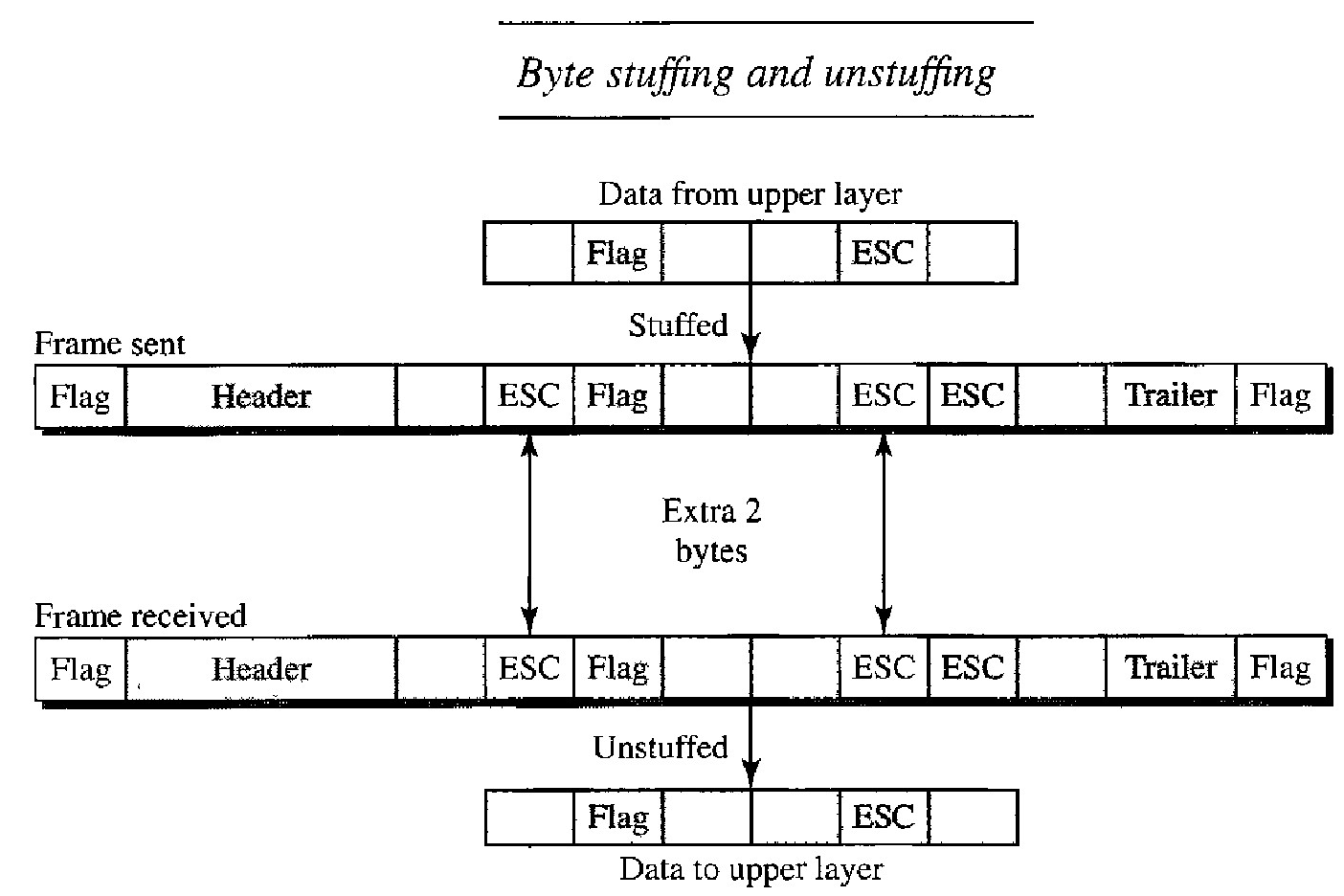
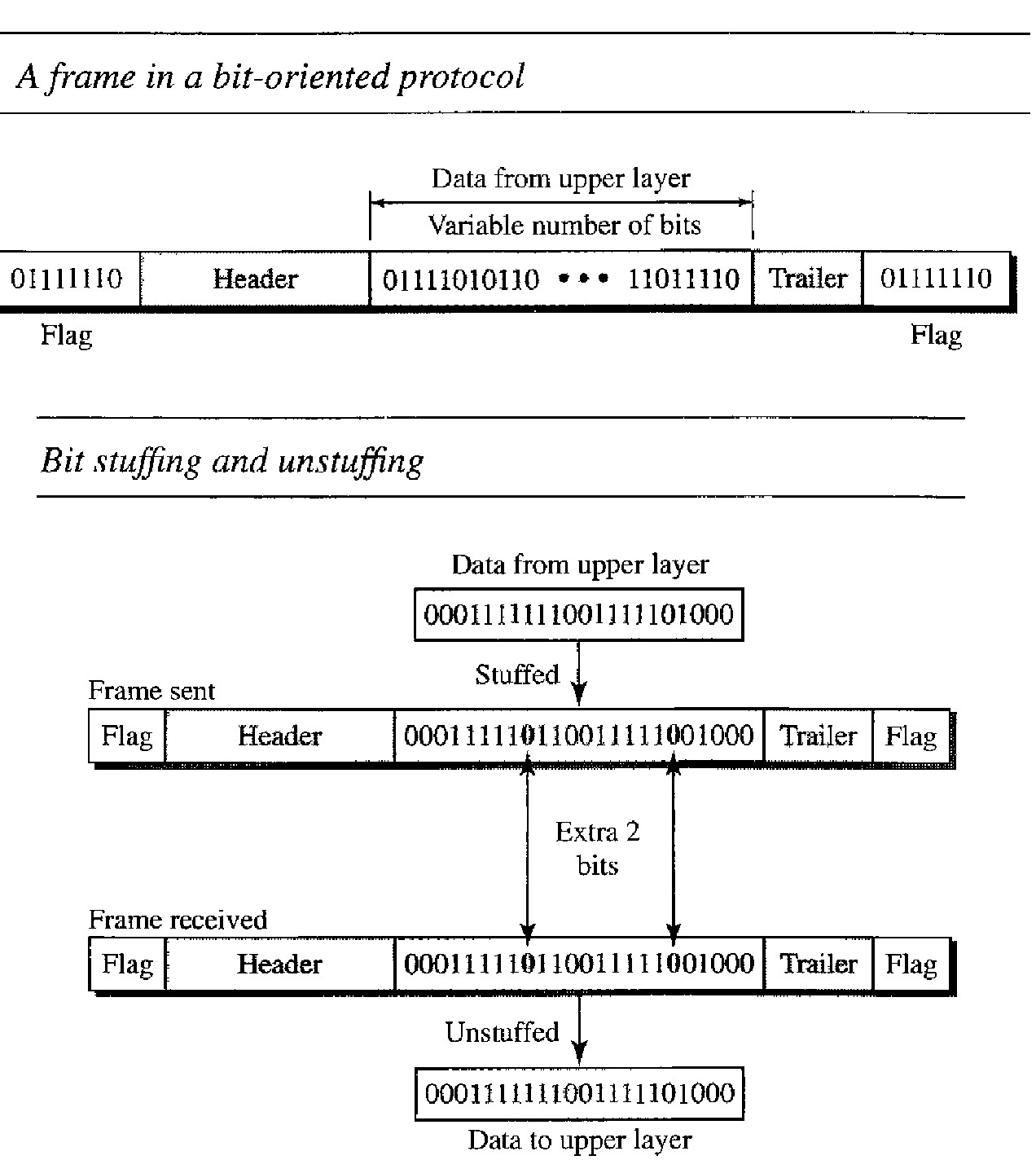
FLOW AND ERROR CONTROL
The most important responsibilities of the data link layer are flow control and error control. Collectively, these functions are known as data link control.
Flow Control :
Flow control refers to a set of procedures used to restrict the amount of data that the sender can send before waiting for acknowledgment.
Flow control coordinates the amount of data that can be sent before receiving an acknowledgment and is one of the most important duties of the data link layer.
The flow of data must not be allowed to overwhelm the receiver. Any receiving device has a limited speed at which it can process incoming data and a limited amount of memory in which to store incom- ing data.
The receiving device must be able to inform the sending device before those limits are reached and to request that the transmitting device send fewer frames or stop temporarily.
Incoming data must be checked and processed before they can be used. The rate of such processing is often slower than the rate of transmission. For this reason, each receiving device has a block of memory, called a buffer, reserved for storing incoming data until they are processed.
If the buffer begins to fill up, the receiver must be able to tell the sender to halt transmission until it is once again able to receive.
Error Control :
Error control in the data link layer is based on automatic repeat request, which is the retransmission of data.
Error control is both error detection and error correction. It allows the receiver to inform the sender of any frames lost or damaged in transmission and coordinates the retransmission of those frames by the sender.
In the data link layer, the term error control refers primarily to methods of error detection and retransmission.
Protocols - Noiseless (error-free) channels and Noisy (error-creating) channels
The protocols are normally implemented in software by using one of the common programming languages.
The protocols in the first category cannot be used in real life, but they serve as a basis for understanding the protocols of noisy channels.
There is a difference between the protocols we discuss here and those used in real networks. All the protocols we discuss are unidirectional in the sense that the data frames travel from one node, called the sender, to another node, called the receiver.
Although special frames, called acknowledgment (ACK) and negative acknowledgment (NAK) can flow in the opposite direction for flow and error control purposes, data flow in only one direction.
In a real-life network, the data link protocols are implemented as bidirectional; data flow in both directions. In these protocols the flow and error control information such as ACKs and NAKs is included in the data frames in a technique called piggybacking.
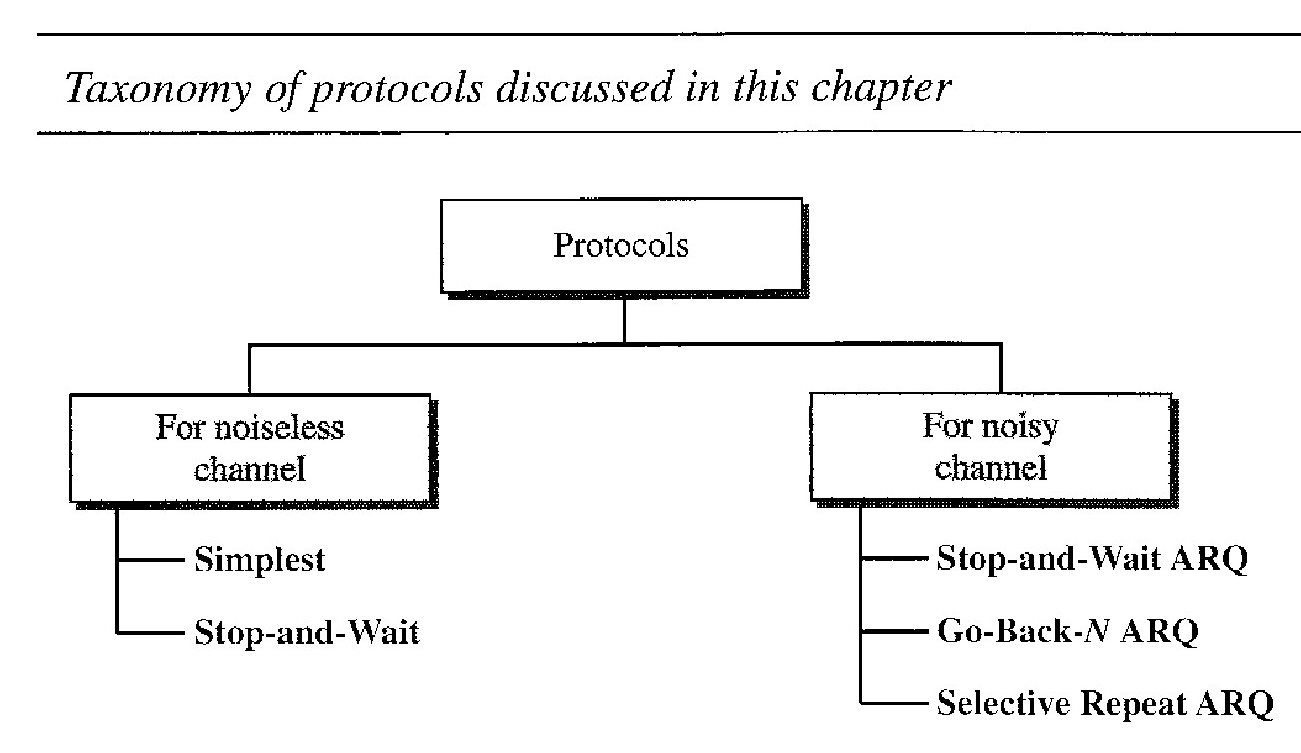
Simplest Protocol
Simplest Protocol for lack of any other name, is one that has no flow or error control. Its a protocol that does not use flow control neither has it got error control because we have assumed that the channel is a perfect noiseless channel.
We assume that the receiver can immediately handle any frame it receives with a processing time that is small enough to be negligible. The data link layer of the receiver immediately removes the header from the frame and hands the data packet to its network layer, which can also accept the packet immediately. In other words, the receiver can never be overwhelmed with incoming frames.
The data link layer at the sender site gets data from its network layer, makes a frame out of the data, and sends it. The data link layer at the receiver site receives a frame from its physical layer, extracts data from the frame, and delivers the data to its network layer.
The data link layers of the sender and receiver provide transmission services for their network layers. The data link layers use the services provided by their physical layers (such as signaling, multiplexing, and so on) for the physical transmission of bits.
The sender site cannot send a frame until its network layer has a data packet to send. The receiver site cannot deliver a data packet to its network layer until a frame arrives. If the protocol is implemented as a procedure, we need to introduce the idea of events in the protocol.
The procedure at the sender site is constantly running; there is no action until there is a request from the network layer. The procedure at the receiver site is also constantly running, but there is no action until notification from the physical layer arrives. Both procedures are constantly running because they do not know when the corresponding events will occur.
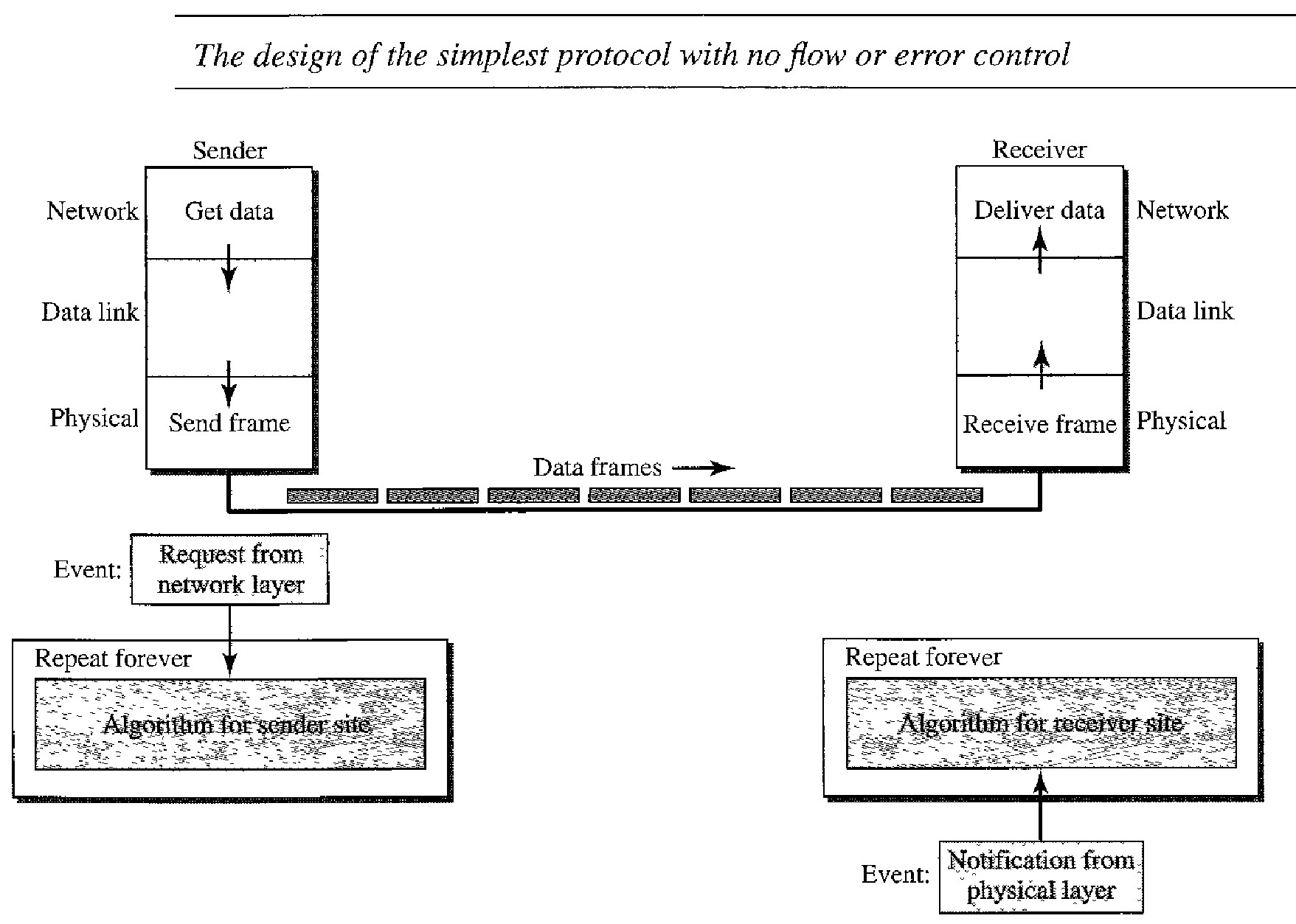
Stop-and- Wait Protocol
If data frames arrive at the receiver site faster than they can be processed, the frames must be stored until their use. Normally, the receiver does not have enough storage space, especially if it is receiving data from many sources.
This may result in either the discarding of frames or denial of service. To prevent the receiver from becoming overwhelmed with frames,we somehow need to tell the sender to slow down. There must be feedback from the receiver to the sender.
Stop-and- Wait Protocol is named because the sender sends one frame, stops until it receives confirmation from the receiver (okay to go ahead), and then sends the next frame. We still have unidirectional communication for data frames, but auxiliary ACK frames (simple tokens of acknowledgment) travel from the other direction. We add flow control to our previous protocol.
As we can see the traffic on the forward channel (from sender to receiver) and the reverse channel. At any time, there is either one data frame on the forward channel or one ACK frame on the reverse channel. We therefore need a half-duplex link.
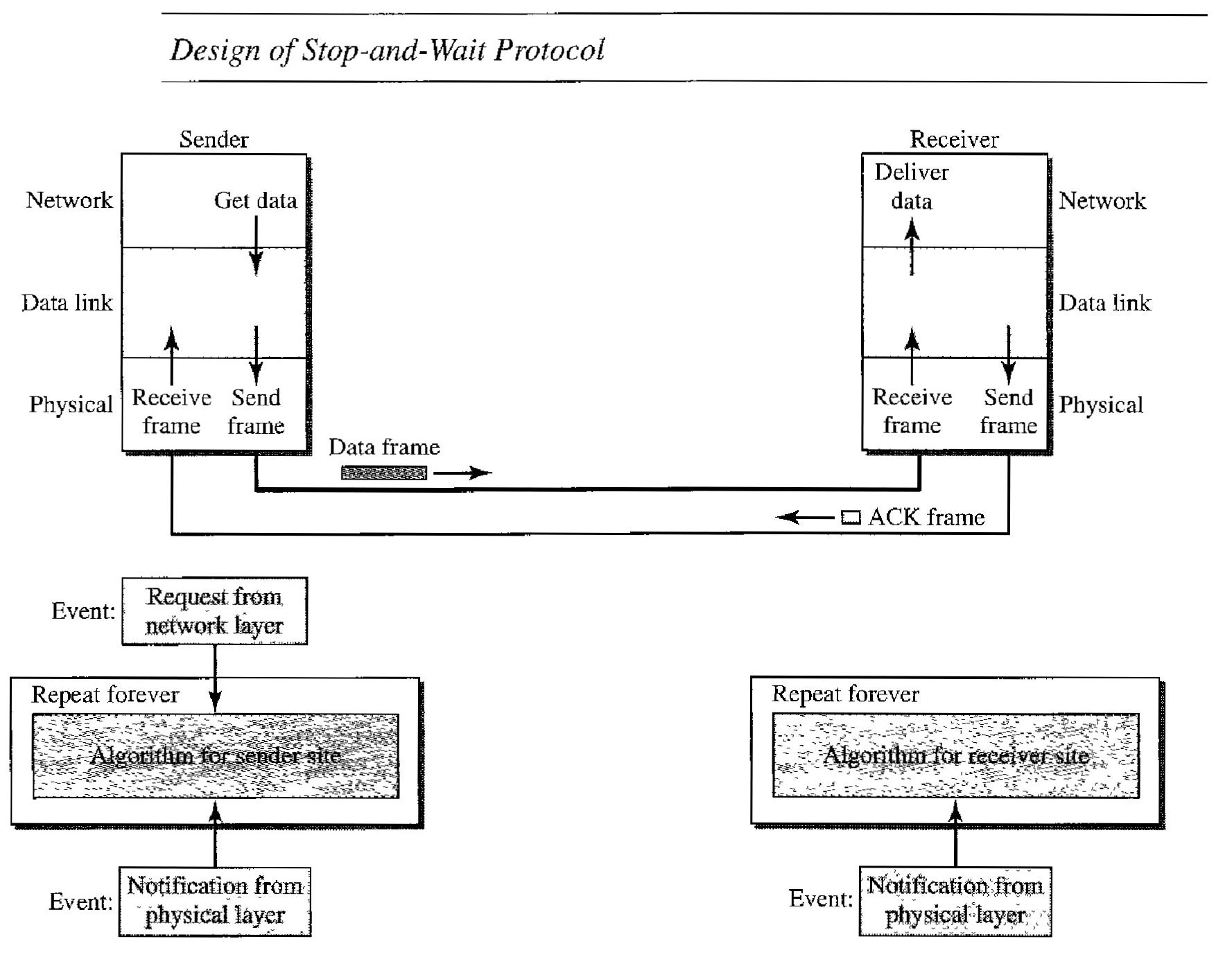
Flow diagram for Stop-and- Wait Protocol
The sender sends one frame and waits for feedback from the receiver. When the ACK arrives, the sender sends the next frame. Note that sending two frames in the protocol involves the sender in four events and the receiver in two events.
